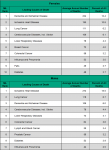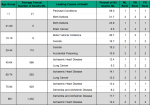Leading Causes of Death
Leading Causes of Death
Public health is responsible for reducing the burden of diseases of public health importance including, among others, those related to:
• healthy growth and development such as birth defects
• infectious disease such as influenza
• chronic diseases such as cardiovascular disease, cancer, dementia, diabetes and respiratory disease
• preventable injuries and substance use disorders1
Awareness of the local leading causes of death helps to focus the development of health promotion and disease prevention programs to prevent disease and reduce deaths.
The top three leading cause of death, accounting for over a quarter of all deaths in Middlesex-London from 2013 to 2015 were:
• ischaemic heart disease
• dementia and Alzheimer disease
• lung cancer
Dementia and Alzheimer disease is a recent addition to Middlesex-London’s top three leading cause list; both heart disease and lung cancer were previously included on the list in 2005 to 2007. The list of leading causes differed by age group, sex and region (urban or rural residence).
| Top Causes of Death | Age group patterns |
| Sex differences | Regional differences |
Top Causes of Death
More than one in 10 people (13.1%) died of ischaemic heart disease, a reduction of blood supply to the heart, in Middlesex-London on average from 2013 to 2015 (Figure 3.4.1).
The top three leading causes of death (i.e., ischaemic heart disease, dementia/ Alzheimer disease and lung cancer) accounted for over a quarter of all deaths (28.7%). The top ten leading causes of death accounted for over half of all deaths (52.5%) in Middlesex-London on average from 2013 to 2015 (Figure 3.4.1).
The top ten leading causes of death were the same as those in Ontario and the Peer Group, and the top six were in the same order for all three jurisdictions (Figure 3.4.1).
Interpretation
The composition of the list for Middlesex-London has changed since the annual average was last reported for 2005 to 2007 (data not shown). There was a substantive increase in the number of deaths reported for dementia and Alzheimer disease in 2013 to 2015 (330; 9.2% of all deaths) as compared to 2005 to 2007 (170; 5.4% of all deaths). In addition, two causes made the leading causes list in ninth and tenth position that were not previously on the list: influenza/ pneumonia and falls. These two replaced the previous two causes ranked ninth and tenth in 2005 to 2007: breast cancer (80, 2.6% of all deaths 2005 – 2007) and urinary system diseases (73, 2.3% of all deaths 2005 – 2007). Changes in the list may be due to general improvements in the prevention and treatment of cancer and stroke. Additionally, the gains in life expectancy have shifted the leading causes of disease to those more prevalent in older aged adults such as dementia and falls.
Sex differences
Females and males share eight out of the top ten leading causes of death from 2013 to 2015 in Middlesex-London (Figure 3.4.2).
The top five leading causes of death for females and males were the same, however the rank order differed for the top three causes between females and males. Dementia and Alzheimer disease was the leading cause of death for women (12.4%) followed by ischaemic heart disease (10.8%) and lung cancer (6.2%). For men, ischemic heart disease was the leading cause of death (15.5%) followed by lung cancer (6.7%) and dementia and Alzheimer Disease (6.0%) (Figure 3.4.2).
Unique to the top ten list for females was breast cancer (4.0%) and falls (2.7%) whereas unique to males was lymph and blood cancer (3.4%) and prostrate cancer (3.2%) (Figure 3.4.2).
The top ten list for females makes up a slightly larger percent of all overall deaths (55.4%) as compared to males (52.3%) same from 2013 to 2015 for Middlesex-London residents (Figure 3.4.2).
Interpretation
Males and females share many of the same leading causes of death however some causes such as breast cancer and prostrate cancer are unique to each sex due to biological factors. Some differences may be related to behavioural factors earlier in life; for example, the higher ranking of ischaemic heart disease and lung cancer in men may be linked to the historically higher rates of tobacco smoking in men. Public health interventions to reduce behavioural risk factors such as tobacco use in the past 20-years may yield the changes in the leading causes in death in both men and women in the future.
Age group patterns
The top two leading causes of death or their order differed by all age groups except for those aged 45-64 and those aged 65-74. Those aged 45 to 74 shared the same top two leading causes of death in ranked order (Figure 3.4.3).
The top two leading causes of death were the same for Middlesex-London, Ontario and the Peer Group in all but those aged 75 to 84 where Middlesex-London’s second leading cause of death was dementia and Alzheimer disease (Figure 3.4.3) but for Ontario and the Peer Group it was lung cancer (data not shown).
Ninety percent of deaths in the first year of life are due to perinatal conditions and birth defects. Fewer deaths occurred in those age 1 to 9 than in those under one year of age and approximately a third of those that do occur are due to birth defects and brain cancer. Among youth aged 10-19, 40% of deaths were due to motor vehicle crashes and suicide (Figure 3.4.3).
Ischaemic heart disease is the leading cause of death in the three age-groups that include those over age 45. Yet, when looking specifically at those aged 85 and older, ischaemic heart disease is replaced by dementia and Alzheimer disease as the leading cause of death (Figure 3.4.3).
Figure 3.4.4 provides additional detail for leading causes of death by adult age groups for Middlesex-London residents from 2013 to 2015.
External causes of death such as suicide, poisoning, and motor vehicle collisions were the leading causes of death in young adults age 20-44. Substance use and disorders joined the top ten list in fourth place for those age 20-44. This was not on the top ten list in 2005 to 2007 for Middlesex-London and its presence is largely associated with the opioid crisis (Figure 3.4.4).
Chronic diseases such as ischaemic heart disease and cancers such as lung, colorectal, breast and lymph and blood cancer become more prevalent in middle age groups. Dementia and Alzheimer disease joins the leading causes of death in those 65-74 and becomes much more common in those age 75 and older. Unique leading causes also appear in those 75 and older such as influenza and pneumonia as well as falls (Figure 3.4.4).
Interpretation
Ranking of the leading causes of death fluctuated widely by age group. In the early years, deaths due to perinatal conditions and birth defects give way to deaths due to external causes such as motor vehicle collisions, suicide and poisonings in youth and young adults. This is followed by death due to chronic diseases such as ischaemic heart disease and cancer in older adults. In the oldest age groups, dementia and Alzheimer disease is also prominent.
Regional differences
Rural and urban population centres shared the same top five leading causes of death in the same order in Middlesex-London from 2013-15. The next five leading causes of death were rank ordered slightly differently and included the same five causes.
(Figure 3.4.5).
Interpretation
There were few differences in the leading causes of death by rural and urban region.
Leading cause of death is based on a single, underlying cause of death for each person coded using the International Classification of Diseases (ICD-10) and grouped for this analysis according to Becker’s Leading Cause Groups for Mortality which is the standard approach using in Ontario public health units. This is important because the rank order of any particular cause of death will depend on the list of causes from which selection is made and on the rules applied to make the selection. Deaths coded as “residual”, a catch-all category not including those coded as “symptoms, signs, ill defined,” where not included in the leading cause list. “Residual” deaths comprised approximately 10% of the deaths and would have been the second leading cause of death in Middlesex-London on average from 2013 to 2015.
Population Health Assessment and Surveillance Protocol, 2018
References:
1. Ontario Ministry of Health and Long-Term Care. Protecting and promoting the health of Ontarians. Ontario public health standards: requirements for programs, services, and accountability [Internet]. Toronto (ON): Queen’s Printer for Ontario; 2018 [cited 2019 Feb 9]. 75 p. Available from: http://health.gov.on.ca/en/pro/programs/publichealth/oph_standards/docs/...
Last modified on: June 21, 2019
Jargon Explained
Ischaemic heart disease
involves the narrowing of the arteries to the heart that leaves them unable to bring enough blood and oxygen to the heart’s muscle.




